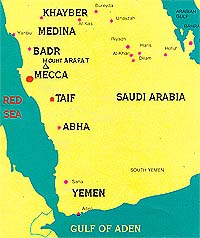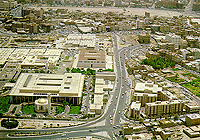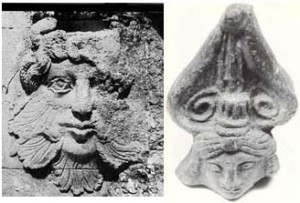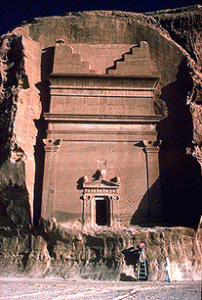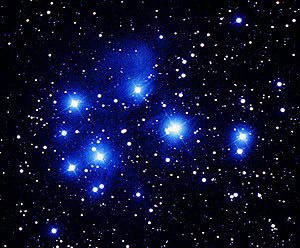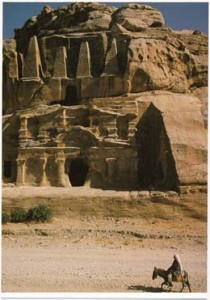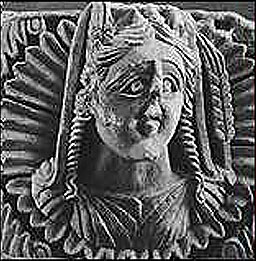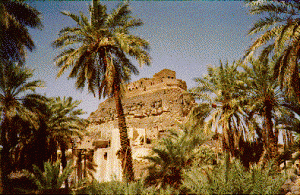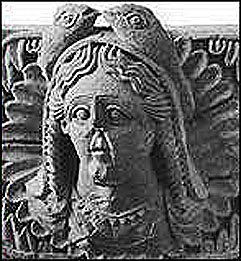Vedic Past of Pre-Islamic Arabia – Part 8
There was a price one had to pay if one wanted to live in the Arabia of the Prophet of Islam . That price was the
surrender of one’s ancestral heritage, and all the values that one held sacred, of forcible subjugation, of curtailment of the individual right to choose one’s god and method of worship. To live in Muhammad’s Arabia, one had to give up the most cherished possession of human existence; that of the individual right to freedom of religion.
Arabia’s Vedic culture had been slashed and ravaged to a state of tatters. In place of the tradition of spiritual tolerance and growth that defined Sanatan Dharma, Arvasthan was now the political center of a fanatical creed that ruled by the sword and held dear the values of extortion, greed and murder.
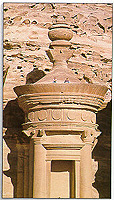 The huge Kalash atop Ad-Deir, an ancient Vedic shrine in Jordan Source: The Art of Jordan
The huge Kalash atop Ad-Deir, an ancient Vedic shrine in Jordan Source: The Art of Jordan
As we have seen, the Prophet was completely unsuccessful in his Siege of the city of Taif . He therefore ended the campaign with the bitterly vituperative act of arson. Mohammad gave vent to his rage by setting fire to every tree around Taif, knowing fully well that such an act was defined as mass murder in the dry desert environs of Arabia. The Prophet was determined not to allow the Tribe of Thaqeef to survive. In order to implement his murderous intentions, Muhammad exhorted the subjugated Tribe of Hawazin (refer to Battle of Hunayn, Vedic Past of Pre-Islamic Arabia Part VII) to mercilessly harass the fortified city. All of the Thaqeef’s herds were stolen at their pastures and all links to the trade with Mecca were severed. Isolated, starved and surrounded by death on all sides, the brave Thaqeef held on to their beliefs and subsisted on dry dates and water for at least one year. The morale of the Tribe collapsed steadily as they watched their children die day by day succumbing to starvation and disease. Those who were of the weakest character, gave in and secretly set out to negotiate terms with Muhammad. Their deputation was led by Urwa Bint Masud Al Thaqafi . Urwa the traitor accepted Islam and emboldened by his new found lease on life, ventured back to Taif to “invite his people to the true faith”. Upon his return, when Urwa “went up to the room to show his people the Way of Islam”, he was bombarded with arrows and died a traitor’s death. The ferocious Thaqeef fought like heroes to the last to preserve the sacred honor of their beloved Mother Goddess, Al-Lat.
In the end of course, even the mighty Thaqeef could not last, they were compelled to send a deputation of six chiefs to negotiate peace with Muhammad. The chiefs were clear in their demands to the Prophet . In exchange for peace, they demanded that their holy territory of Wajj remain untouched, they would not break the idols of their beloved goddess Allat, no more trees could be cut down and the Thaqeef would retain their vineyards. Muhammad in his greed for the prosperous prize of Taif agreed, he even signed the treaty as Muhammad Ibn Allah foregoing the usual status of “Messenger of God” Allah at the insistence of the Thaqeef . It is another story of course, that he had ulterior motives in mind.
The Thaqeef were satisfied with the terms of the treaty and prepared to return home. Muhammad insisted that one of the traitors of Taif ,Al-Mughira, Abu Sofyan the traitorous leader of Mecca and a sizeable, Muslim army be allowed to follow them. The Thaqeef although suspicious, agreed in good faith. Upon reaching Taif, the Muslims showed their true colors. Al Mughira and his army surrounded the Temple of Allat and started smashing the idols with axes. Abu Sofyan even in his traitorous element was moved to cry out “Alas O Goddess! Alas!” Hundreds were massacred in sight of their families. The women of Taif collected in the streets, dishevelled and bare-headed, beating their breasts and weeping at the loss of their protectress, and the the inadequacy of their men who failed to protect her. As the unprepared Thaqeef were slaughtered, the anguished women cried out:
Weep! Weep for our protector!
Poltroons would neglect her
Whose swords need a corrector.
Every scrap of gold, jewellery and gems was plundered. Women and children were enslaved, the only ones who survived were those who were weak enough to bend at the threat of the Muslim sword and convert to Islam.
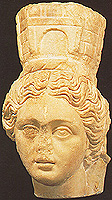 Al-lat (Durga) of Amman Source: The Art of Jordan
Al-lat (Durga) of Amman Source: The Art of Jordan
There were many other Temples in the vicinity of Taif , all of which were plundered, then destroyed or converted into mosques. Most of the temple fragments were buried underfoot so that the Prophet could satisfy his constant burning need to vituperate and insult the religion of his own ancestors. Among the temples that fell prey, were most of the shrines of Ruda (Rudra or Lord Shiva), Allat and Al-Uzza (forms of Shakti).
The consistent appearance of Temples dedicated to the divine couple of Shiva-Shakti throws light on the essential spiritual principles that the Hindus of Pre- Islamic Arabia upheld. Numerous instances support the preeminence of Shiva-Shakti worship in Arabia. The most obvious example is that of the Kaaba in Mecca.
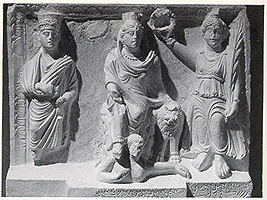 Allat of Palmyra Source: Palmyra & its Empire
Allat of Palmyra Source: Palmyra & its Empire
The Kaaba was dedicated to Al-lat and Al-Uzza both of which are forms of the Mother Goddess Shakti. The structure of the temple attested to the fact that it was based on the Tantric iconography of Devi Durga . The verses as written in the Devi-Mahatmya texts of the Markandeya Purana describe the formation of her physical body and iconographical attributes:
Born out of the bodies of all the Gods, that unique efflugence, combined into a mass of light, took the form of a woman, pervading the triple worlds with its lustre. In that efflugence,
the light of Shiva formed the face. The Tresses were formed from the light of Yama and the arms from the light of Vishnu Bhagwan
The two breasts were formed from the moon’s (Somanath’s) light, the waist from the light of Indra, the legs and thighs from the light of Varun, and hips from the light of the Earth (Bhoodev)
The feet from the light of Brahma
and the toes from Surya’s (sun) light,
the fingers of the hand from the light of the Vasus(the children of Ganga)
and the nose from the light of Kuber .
The teeth were formed from the light of Prajapati, the lord of beings; likewise the Triad of her eyes was born from the Light of Agni (fire). The eyebrows from the two Sandhyas (sunrise and sunset) ; the ears from the light of the wind(Vayu). From the lights of other gods as well, the auspicious goddess was born.
Projecting an overwhelming omnipotence the three eyed goddess adorned with the crescent moon with her eighteen arms each holding auspicious weapons, emblems, jewels and other gifts offered by individual gods, emerged. With her pulsating body of golden color shining with the splendour of a thousand suns, standing erect on her lion vehicle (vahana) and displaying her triumph over the dark forces (shown in the form of a demon under her feet), she stands as the most spectacular personification of cosmic energy.
Among the 360 idols which surrounded the main shrine of the destroyed Kaaba were 16 magnificient ones that bordered the sanctum sanctorium. We know the names of the gods that inhabited these 16 important shrines. Every single one of these deities matches the Devi-Mahatmya’s textual description of Devi Durga:-
Suwa which apparently stood for Lord Shiva
Ayam which stood for Lord Yama
Bag which stood for Bhagwan Shri Vishnu
Manat which stood for Somnath (Moon)
Sakiah which stood for Sakra (another name for Indra)
Al-Debaran which stood for Dev-Varun
Obodes which stood for Bhoodev (Earth)
Awal (first) which stood for Brahma
Shems which stood for Surya (Sun)
Wajj (pronounced “Vazz”) which stood for the Vasus who were the seven sons of Ganga (corrupted to Zamza in the form of the ZamZam spring in the Kaaba)
Kaber which stood for Kuber
Aja which stood for Prajapati
Makha which stood for Agni (fire) (in Sanskrit Makha means a fire-sacrifice (Yagna), the city of Mecca got its name because of the fact that it was the site of the fire sacrifice)
Sunrise and
Sunset, called the two Auses which stood for the two Sandhyas (probably taken from Ushas)
Ha’uw which stood for Vayu (the wind)
The architectural elements of the Kaaba Temple consisted of a square block of black stone, crested by a crescent and sphere, which is encircled by 360 shrines. This is an exact representation of the Tantric Cit-kunda Yantra. Each element of the Yantra was represented in the Kaaba complex. The circle or Bindu symbolizes Shakti , it is embraced by the crescent or Shishu which symbolizes Shiva. This divine marriage shows the pure pre-creative stage of evolution. The beginning of creation is an omnipotent all-pervading cosmic principle – Shiva embracing his potential power -Shakti . Thus the crescent and moon symbol is the sign of the Self, which is aware of its inherent dynamic power. The four points of the square stone represent the four aspects of one’s psyche: the pure self (atman), the inner self (antaratman), the cognizant self (jananatman) and the supreme self (paramatman) . The circle around these symbols represents both the wheel of time (the Vedic year consisted of 360 days) as well as the astronomical map of the universe and its 360 major heavenly bodies. The Kaaba in its symbolism therefore represented all the cosmic principles of the universe. It is the height of absurdity to call proponents of a culture that was capable of producing monuments such as these, as “superstitous polytheists and uncivilized pagans”. The fact is that the Prophet of Islam destroyed a culture that was vastly superior in all scientific, spiritual, humanistic and symbolic respects, to his brand of theocracy. Ironically the word “Pagan” which has come to mean animalistic, has its very roots in the malpronounciation of the word “Bhagwan” (Divine God).
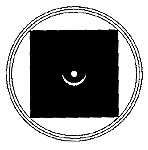 Cit-Kunda-Yantra the Tantric pattern that the Kaaba is based upon.
Cit-Kunda-Yantra the Tantric pattern that the Kaaba is based upon.
There is even more evidence that clearly suggests the conclusion that the Arabs used to worship different forms of the Divine Couple, Shiva-Shakti in many forms. Archaeological remnants of the Nabataeans who inhabited Arabia in the Pre-Islamic era, demonstrate that the chief deities were Dhu-Shara and Al-Uzza. As we already know Uzza was none other than Oorja or Shakti and since Du-Shara was her husband, it is quite logical to conclude that Du-Shara is a corruption of “Deveshwar” which is a Sanskrit synonym for Lord Shiva . Herodotus in his Histories also says of the Arabs ” They deem no other to be gods save Dionysus and Heavenly Aphrodite … they call Dionysus Orotalt and Aphrodite Alilat” (Negev 101). Alilat was again the corrupted version of Allat who as we know represented Alla (Durga). Dionysus her husband has all the traits of Shiva as well. Lord Shiva was known to have intoxicated followers called “Ganas”. He was also known as “Pashupati” (lord of the beasts). He is always depicted wearing a Tiger Skin. The greatest clue to the Shaivite origin of Dionysus lies in the undeniable title of “fertility god”. Just as the Shivling represents the creative energy, so too were phallic symbols made to represent Dionysus, the fertility God. Another clue that supports this conclusion is the fact that Du-Shara is represented as being surrounded by dolphins, as is Dionysus. It is quite plausible to suggest that Du-Shara and Dionysus were names for Lord Shiva and that their spouses Al-Uzza and Al-lat respectively, were names for Shakti.
Astrological references in the Vishnu Puran describe the shape of space in the following way:
“The heavenly form of the mighty Lord is made of stars and shaped like a dolphin with Dhruva (the Pole Star) in its tail. This dolphin shaped constellation which is the pathway of the stars’ fixed abodes has its hub in the heart of the Lord. The sun, moon, stars and nakshatras together with the planets are bound to Dhruva in the tail of the Dolphin by fetters made up of a series of winds”.
It is quite obvious that the Dolphin shaped constellation which represents the Hindu concept of the cosmos is the basis for Nabatean representations of dolphins in their sacred temples. They represented Du-Shara wielding a trident along with his consort Al-Uzza seated on a lion, surrounded by dolphins. The entire divine scene thus symbolized Shiva-Shakti and the shape of the spatial universe as envisioned by Vedic culture.
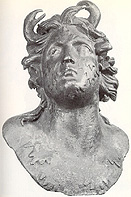 Du-Shara, the, Nabataean version of Lord Shiva. Source: Deities and Dolphins
Du-Shara, the, Nabataean version of Lord Shiva. Source: Deities and Dolphins
Dhruva himself was venerated in many Arab temples. He was worshipped as Duar in the Kaaba complex, where many other astronomical deities were revered. The Navagrahas or nine planets of Hindu cosmology each had an individual shrine dedicated to them in the Kaaba. We know the Arabic names for at least five of them.
Sanskrit – Arabic – English
Budh – Wad – Mercury
Surya – Shems – Sun
Somanath – Manat – Moon
Shani – Al-Dsaizan – Saturn
Shukra – Al-Sharak – Venus
he parallels are far too numerous to overlook. The Vedic theme that underlies the Kaaba and many Arabic temples, is apparent, when we add up all these fragments of evidence and consider them as a whole.
The fact that Muslim scholars have over the centuries tried their best to erase all such pieces of evidence speaks volumes. These irrefutable testaments to the Vedic origins of Arabia, were erased off the face of the earth by the Prophet of Islam in his quest for supremacy. Although only a few traces could survive the destructive assault of Islam, the truth still echoes from the silent remains of Nabataea, Sabaea, Palmyra and Dura-Europos, which eloquently tell of Arabia’s past.
The stories that these ruins whisper have been ignored for centuries, it is time that they too were heard and given their rightful place in the history of Vedic civilization and the world.
Aditi Chaturvedi
Note: The Works “The Life & times of Muhammad” by Sir John Glubb, “Mohammed” by Anne Carter, “Yantra, the Tantric symbol of Cosmic Unity” by Madhu Khanna, “Deities and Dolphins by Nelson Glueck, “Classical Hindu Mythology” by Dimmitt and Buitenen, and “Hindu Temples: What Happened to Them? – Volume 2” by Sita Ram Goel have been used to compose this article.
___________________________________________________________________________________________________________________

